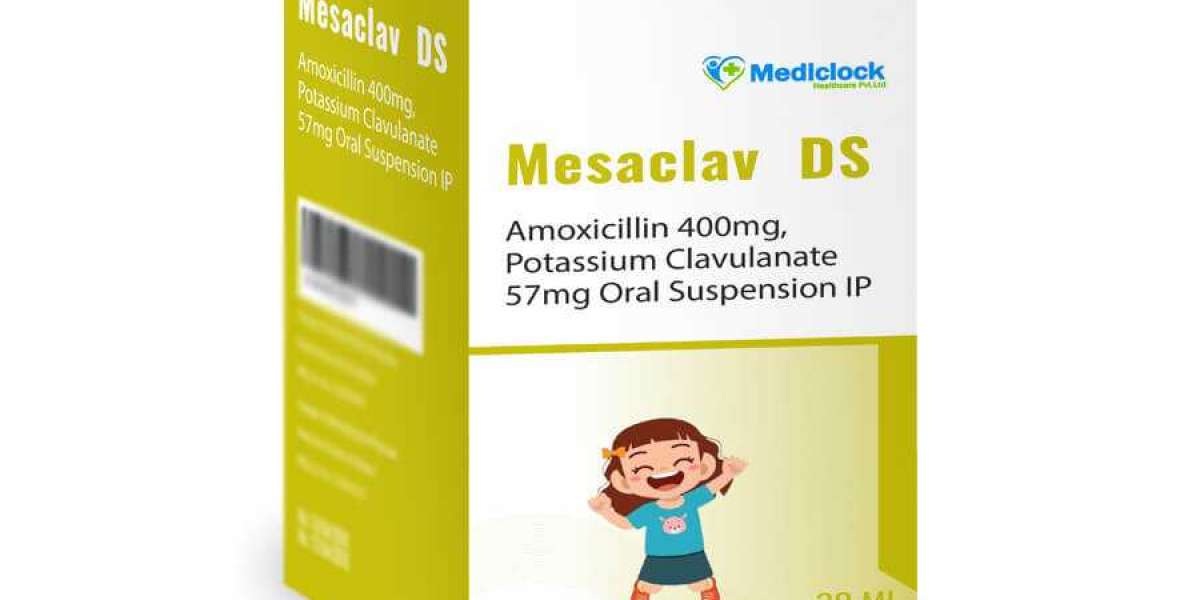Amoxicillin Potassium Clavulanate Oral Suspension IP is a widely used antibiotic combination indicated for the treatment of various bacterial infections in both adults and paediatric patients. This oral suspension is effective against a range of infections, including lower respiratory tract infections, otitis media, sinusitis, skin and soft tissue infections, and urinary tract infections. Additionally, it is utilised in veterinary medicine for treating periodontal infections in dogs and skin and soft tissue infections in cats. The medication combines amoxicillin, a potent antibiotic, with clavulanate potassium, a β-lactamase inhibitor that enhances amoxicillin's effectiveness by preventing bacterial resistance mechanisms.
Dosage and administration of Amoxicillin Potassium Clavulanate Oral Suspension IP are tailored based on the type and severity of the infection, as well as the patient's weight. The recommended dosages for adults typically range from 500 to 875 mg every 12 hours, or 250 to 500 mg every 8 hours, depending on the severity of the infection. It is crucial to take the suspension with food to minimise gastrointestinal side effects. However, caution is advised in patients with a known history of hypersensitivity to penicillin or cephalosporins, as the medication is contraindicated in such individuals. Patients should be vigilant for signs of hypersensitivity reactions and discontinue the medication if any adverse effects occur. Additionally, the medication should only be used to treat bacterial infections and not viral infections to prevent unnecessary antibiotic use and the development of antibiotic resistance. Overall, Amoxicillin Potassium Clavulanate Oral Suspension IP is a valuable therapeutic option for combating bacterial infections, offering a well-established safety and efficacy profile in clinical practice.
Mechanism of Action: Amoxicillin inhibits the synthesis of bacterial cell walls, while clavulanate potassium inhibits β-lactamase enzymes produced by bacteria, which can degrade amoxicillin. By combining these two components, the medication is able to effectively combat a wide range of bacterial infections.
Pharmacokinetics: Amoxicillin Potassium Clavulanate Oral Suspension IP is rapidly absorbed from the gastrointestinal tract and achieves high concentrations in various body fluids and tissues. The medication is primarily excreted in the urine, with a small fraction eliminated in the faeces.
Dosage and Administration: The dosage of Amoxicillin Potassium Clavulanate Oral Suspension IP is tailored based on the type and severity of the infection, as well as the patient's weight. For adults, the recommended dosages typically range from 500 to 875 mg every 12 hours, or 250 to 500 mg every 8 hours, depending on the severity of the infection. It is crucial to take the suspension with food to minimise gastrointestinal side effects.
Contraindications and Precautions: Amoxicillin Potassium Clavulanate Oral Suspension IP is contraindicated in patients with a known history of hypersensitivity to penicillin or cephalosporins. Patients should be vigilant for signs of hypersensitivity reactions and discontinue the medication if any adverse effects occur. Additionally, the medication should only be used to treat bacterial infections and not viral infections to prevent unnecessary antibiotic use and the development of antibiotic resistance.
Adverse Effects: Common adverse effects of Amoxicillin Potassium Clavulanate Oral Suspension IP include diarrhoea, nausea, and skin rashes. In rare cases, severe adverse effects such as anaphylaxis, Stevens-Johnson syndrome, and toxic epidermal necrolysis may occur.
Drug Interactions: The medication may interact with other drugs, including probenecid, which can increase amoxicillin concentrations in the blood. Patients should inform their healthcare provider of all medications they are taking to avoid potential drug interactions.
Paediatric Use: The safety and effectiveness of Amoxicillin Potassium Clavulanate Oral Suspension IP in paediatric patients with a body weight of less than 40 kg have not been established. Therefore, the medication should only be used in paediatric patients under the guidance of a healthcare provider.
- Indications and Usage: Amoxicillin Potassium Clavulanate Oral Suspension IP is indicated for the treatment of infections in adults and paediatric patients caused by susceptible microorganisms. These infections include lower respiratory tract infections, acute bacterial otitis media, sinusitis, skin and skin structure infections, and urinary tract infections. The suspension is also used to treat periodontal infections in dogs and skin and soft tissue infections in cats.
- Dosage and Administration: The dosage regimen for Amoxicillin Potassium Clavulanate Oral Suspension IP varies based on the type of infection and the patient's weight. For adults, the recommended dosage is 500 or 875 mg every 12 hours or 250 or 500 mg every 8 hours, based on the amoxicillin component. The suspension should be taken with food to minimise gastrointestinal intolerance.
- Contraindications: Amoxicillin Potassium Clavulanate Oral Suspension IP is contraindicated in patients with a known history of hypersensitivity to penicillin or cephalosporins.
- Warnings and Precautions: Patients should be advised to stop taking the medication if mucosal lesions or any other sign of hypersensitivity occurs. Diarrhoea is a common problem caused by antibacterial drugs, and if severe or lasting more than 2 or 3 days, patients should contact their doctor. The medication should only be used to treat bacterial infections and not viral infections.
- Drug Interactions: Probenecid decreases the renal tubular secretion of amoxicillin, which may result in increased and prolonged blood levels of amoxicillin. Co-administration of probenecid is not recommended.
- Use in Specific Populations: The safety and effectiveness of Amoxicillin Potassium Clavulanate Oral Suspension IP in paediatric patients with a body weight of less than 40 kg have not been established.
- Overdosage: In case of overdose, patients should seek immediate medical attention or contact a poison control centre.
- Description: Amoxicillin Potassium Clavulanate Oral Suspension IP is an oral antibacterial combination consisting of the semisynthetic antibiotic amoxicillin and the β-lactamase inhibitor, clavulanate potassium.
- Clinical Pharmacology: Amoxicillin is an analog of ampicillin, derived from the basic penicillin nucleus, 6-aminopenicillanic acid. Clavulanic acid is produced by the fermentation of Streptomyces clavuligerus and is a β-lactam structurally related to the penicillins.
- Clinical Studies: The safety and effectiveness of Amoxicillin Potassium Clavulanate Oral Suspension IP in treating infections in adults and paediatric patients have been established in clinical studies.
- How Supplied/Storage and Handling: Amoxicillin Potassium Clavulanate Oral Suspension IP is supplied as a powder for oral suspension. The reconstituted suspension should be refrigerated and discarded after 14 days.
- Patient Counselling Information: Patients should be advised to take the medication as directed and complete the full course of therapy. They should also be informed of the potential for allergic reactions and the importance of seeking immediate medical attention if they occur.
In conclusion, Amoxicillin Potassium Clavulanate Oral Suspension IP is a valuable therapeutic option for combating bacterial infections, offering a well-established safety and efficacy profile in clinical practice. By combining the potent antibiotic amoxicillin with the β-lactamase inhibitor clavulanate potassium, the medication is able to effectively combat a wide range of bacterial infections. However, it is important to use the medication appropriately and under the guidance of a healthcare provider to ensure safe and effective treatment.








